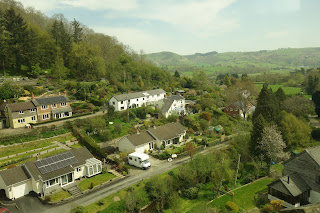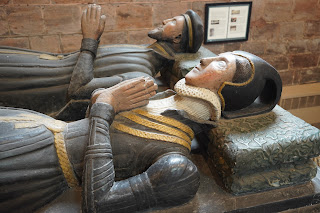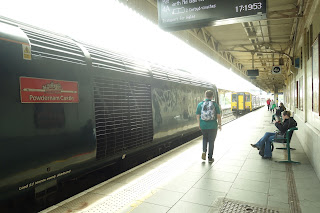The heart of Wales line
Llanelli, Llangennech, Llandybie, Llandeilo, Llanwrdam, Llandovery, Llanwrtyd, Llanganmach,
Llandrin dod, Llanbister, Llangynllo – 11 of the 26 stops along the 4 hour, 194 km ride from Swansea to Shrewsbury have the word Llan in it. Llan means church, explains the chap I share the train with – there are no other passengers when we leave Swansea. It is one of the few words in Welsh he knows. Coming from London he does not speak Welsh. He moved to Llandowery for his retirement. This little train is his connection with the world. Cheaper and more convenient than a car. For the time being he can work from home – he is a consultant - and even from the remoteness of this little train. The Wifi works flawless.
Railcar to Shrewsbury in Swansea station
This is the last of various train lines crossing the Welsh interior from South to North. Few through travelers take this train – the main line via Cardiff and avoiding the highlands is faster. Degraded to a secondary line the two hourly railcar stops everywhere. If you want to, because some of the stops are on demand. On the train the conductor keeps track of where everybody wants to get off – which is not a lot of trouble with only two passengers. The train slows down at such a stop and continues if nobody appears at the platform. At every station there is a sign: blow horn before departure. Most stations have a level crossing at the end of the platform. If you consider the remoteness of the stops the stations are well maintained. The Victorian woodwork is freshly painted, there is the old-fashioned letterbox and containers planted with flowers.
We continue up a fertile valley to the foot of the mountains. Tak tak – tak tak – tak tak – tak tak …. the sound once typical for every train ride has become rare after modern tracks were welded and not lashed together. I hate to doze away and miss the beautiful countryside. Branches brush the side of the train. Green meadows are lined by hedges. Sheep with lambs hobbling unwieldy away from the roaring monster. After Llandovery we start to climb into the mountains. Tunnels and viaducts with a sweeping view of houses built in natural stone in deep valleys. The short tunnel at Pontarddulais built in 1839 is the oldest still in use in Wales.
The lines reaches its first summit at Sugar Loaf Halt. It is only at a height of 250 m, but to climb up to here the – for railways – considerable gradient of 1 in 60 is needed. At the 915 m long Llangynllo Tunnel, the highest point on the route at 299 m, the line passes through the black mountains.
In 1987 heavy flooding caused the collapse of Glanrhyd Bridge near Llandeilo. The early morning northbound train plunged into the swollen River Towy. Four people were killed. The line was only reopened because of long protests of the locals. For a long time the number of trains was restricted because there were only 2 loops for passing were left. The reason was that the mechanics of the points was so outdated that there were no replacement parts and the points had to be decommissioned.
Two employees of Trafnidiaeth Cymru (transport for wales) have replaced the friendly gentleman in Llandowery. They seem to ride for no particular reason. To enjoy their boxed lunch. Then, just for a few stops, a class of school kids. All clad uniformly in a reflective green vest. Well behaved, for once. Maybe because of their age, or because they are kids from the countryside. Or because this means of transport is new for them….
The place names change, Llan disappears. We have crossed the English border into Shropshire. The train picks up speed. The line is flat now all the way to Shrewsbury.
Being only 15 km from the Welsh border, Shrewsbury played a crucial role in the English conquest of Wales. Already in 1074, Roger de Montgomery, a relative of William the Conqueror, built a castle protecting the only entry into the town. The other sides are enclosed by the loop of the river Severn. In the beginning of the 13th century Llywelyn ab Iorwerth, the Great, became the ruler of much of Wales. Ar the time it was called Gwynedd. Meanwhile they have changed that to Cymru. Both in 1215 and in 1234 he conquered Shrewsbury. The welsh danger led to an improvement of the fortifications. Remainders of the medieval walls can be seen in many parts around old Shrewsbury.
Shrewsbury station
For a little town Shrewsbury has a magnificent, big station. The Mock Tudor building features a clock tower, imitation Tudor chimneys and carved heads in the frames of every window. It is so big that the tracks and platform extend onto a bridge across the river Severn. Little has changed since the last steam engine has disappeared from here in around 1967. The coffeeshop in the building on the island platform has been taken by a fashionable chain compensating quality with price. The castle still overlooks the station and the main road, the only entrance climbing up into town. The main road is lined with old half timbered houses, most of them with a pub at street level. In one I have got my room. I pick up the key at the counter and resist to order a drink right away. The pub has a back entrance from the path beneath the castle walls. The beer garden is overshadowed by the castle. It is raining. I climb up the claustrophobic staircase and I have a cup of tea in my room. God bless British hotels which always have a water cooker and a selection of tea and coffee sachets.
Footbridge across the station
Extension of the platforms across river Severn
The great days of Welsh history were dominated by a confusing succession of rulers either called Llywelyn or Dafydd. To make it more confusing one even changed his name when he assumed office. The first Llywelyn, the Great, became King of Gwynedd and had his headquarters at Abergwyngregyn on the north coast. After a failed truce with King John of England his successor King Henry III in 1218 confirmed Llywelyn the Great as Prince of Wales until his death.
The pub where I stayed
While this agreement with the Great lasted until he died in 1240 King Henry III of England would not allow Llywelyn’s son Dafydd ap Llywelyn to inherit his father's position. This started a whole series of conflicts, which were only resolved in 1267 when King Henry III signed another treaty to confirm Llywelyn II’s (Llywelyn ap Gruffudd also known as Llywelyn Ein Llyw Olaf (Llywelyn, Our Last Leader, nephew of Dafydd, two generations after the Great Llywelyn) control over most of Wales. Problems started again when the next King of England Edward I declared war on Llywelyn II in 1276. Llywelyn II was reasonable and surrendered without battle. He stayed in power but his authority was restricted. However, Llywelyn's brother Dafydd ap Gruffudd did not agree with such a submissive position. In 1282 Dafydd ap Gruffudd was stupid enough to attack Hawarden Castle. Llywelyn had to pay for it. On December 11th 1282 he was lured in a trap, murdered and his army destroyed.
View of the castle from the pub's beer garden
The culprit brother, Dafydd ap Gruffudd, did not give up his vain resistance. He was captured in June 1283. Edward held a Parliament at Shrewsbury Abbey to decide the fate of the last free ruler of Wales. Dafydd was convicted for high treason and hanged, drawn and quartered in Shrewsbury. Thus ended Welsh independence.
I ask myself why there few Welsh license plates can be seen in the streets of Shrewsbury.
To enforce his dominion of Wales, Edward had built an impressive ring of stone castles and gave the title Prince of Wales to his son in 1301. Notwithstanding a number of future rebellions, Wales effectively became part of England, even though its people spoke a different language and had a different culture. As a consequence of the rebellions the English parliament passed laws against the Welsh people in 1402 which prohibited the Welsh from carrying arms, from holding office and from dwelling in fortified towns. These prohibitions also applied to Englishmen who married Welsh women.
Shrewsbury Abbey stands across the railway tracks slightly outside the old town at a place aptly called abbey foregate. The unusual red sandstone building resides stoic above the roar of the traffic in the surrounding streets. It was found already in 1083 by Roger de Montgomery as part of a Benedictine Monastery. The grounds of the monastery are now a big parking lot. To remind of what was there before it is decorated with the pulpit of the former refectory. The gatehouse, the only other surviving building, houses the Shropshire wildlife trust. If you don’t arrive by car it is difficult to visit them without loosing your life while crossing the road. To be honest, a lot of the buildings and the transepts of the cathedral were already destroyed in 1540. In the civil war parts of the church were destroyed to prevent the Royalists from using it.
Shrewsbury Abbey
Inside the cathedral it is an oasis of peace. For the present day visitor it is always difficult to understand the iconography inside churches. Fortunately Shrewsbury Abbey offers good explanations for many of the statues and monuments in the church. Sometimes the monuments give an interesting insight into medieval life and habits.
Along the wall, between a radiator and some publicity for the missionary activities of the church I find the tomb of Rogier de Montgomery, the founder of Shrewsbury, who, as head of the Benedictine monastery, initiated the building of the church in 1095.
Because the churches in this area are built from soft sandstone in the 19th century many of the churches in the countryside were in ruin. Tombstones and artifacts were moved to Shrewsbury Abbey.
Many of the grave monuments display two sculptures. On this tomb of the 12th century from St. Alkmunds church in Shrewsbury the two figures show the same man, first as a soldier then as a priest. Close to the wall he wears a sword and at the aisle religious clothing. At the feet of the figures are lions to protect the deceased in the afterlife. Or prevent them from coming back, thus protecting the living.
This might be a copy of the monument for Walter de Dunsterville, Baron of Castle Combe,
who died in 1195. His image is equipped with a sword and also has the remains of an animal at his feet. The crossed legs of a knight might be a sign that he took part in a Crusade.
The grave of the Onslows from the 16th century is much younger. It was moved to the Abbey in 1788 when the central tower of the 13th century St Chad's Church collapsed and destroyed most of the building. Richard Onslow was Speaker of the House of Commons, Recorder of London and Solicitor General during the reign of Elizabeth l. He died in 1571 and here he rests with his wife Katharine. The fries at the base of the tomb shows figures of their children and coats of arms. When the grave was moved in 1980's some remaining descendants of the Onslow family attended.
The tomb of Alderman William Charlton and his wife was constructed in the 1540s. It was moved here in 1789. Around the chest of the tomb, angels and other religious figures are depicted together with heraldic shields. Of particular note are four figures of Bedesmen, whose duty was to pray for the souls of their benefactors listed on a Bede Roll, which later became Rosary Beads.
All these people lived in those half-timbered black-and-white houses which still line the streets of Tudor Shrewsbury today. Although some have been badly disfigured by tearing out the ground floor facade and replacing it by a modern shop window, a lot of them have been beautifully restored.
One example is Abbot's House from around 1500 on Butcher Row. It is a remarkably complete and significant surviving example of a late medieval town house with original shop units. Note the 4 canted oriel windows flanked by 3-light casements projecting on brackets, if you know what I am talking about.
Modern decorations hidden on the timber frame of an old pub
A coffee shop has settled in one of Shrewsbury High Street's classic timber framed Tudor buildings. Restoration works done in the 1990s seem perfect, until you have a closer look. In a part of the carvings you will discover the heads of Margaret Thatcher and Michael Heseltine back to back, the words 'Poll Tax' are behind them. Other carvings include motorcycles and distorted cars. In less humorous countries such a joke would cost the owner his subsidy for monument restauration.
In many of the timber framed buildings the upper floors overhang the ground floor. The weight is supported by a beam traditionally known as a 'Dragon Beam'. At this house the dragon symbolically supports the 1. floor corner.
On Shrewsbury's town square the Old Market Hall reflects the prosperity of the town in the 16th century. Built from local Grinshill sandstone in 1596 in only 4 month it was one of the earliest examples of prefabricated buildings. The lower level was used by farmers to sell corn and the upper level by dealers in cloth and wool. Today, the upper level has been lovingly restored and opened as a contemporary cinema and cafe bar. Below the homeless have a dry spot to take care of their hangover or harrass the passer-by.
Even though much is preserved, the second half of the 20th century saw some striking examples of lack of building conservation. Many important buildings were lost and replaced with mid-century buildings not befitting a medieval county town. Some, like the replacement of the Victorian market hall, even won an award. Probably it has to be considered that those awards are given by architects to their fellow architects.
Entrance to the prison
Outside town the former prison is now open for Jailhouse Tours. The building was used for 220 years and will be redeveloped, Maybe you will be able to buy a cell. The gate is a bit similar to the one giving access to the castle.
In recent times Shrewsbury has produced more remarkable inhabitants. Charles Darwin was born in Shrewsbury on 12 February 1809. The town's river and countryside inspired his interest in the natural world and the abundance of ice-age boulders within the town sparked his interest in geology.
Charles Darwin in front of the school he attended. Now the city library
A statue on town square depicts Clive of India, one of the most controversial figures in British colonial history. For the establishment of British rule in India in the 18th century he was one of the most important leaders. 35 years old, he returned home after his first campaign in 1760 with a fortune of £300,000 (equivalent to £48,300,000 now). From 1762-1763 he became mayor of Shrewsbury. This short period was enough to secure him such a prominent spot on the town square. However, a sign lines out that his position was not undisputed. When he died in 1774, 49 years old, with a knife in his hand, from a wound at his throat, Samuel Johnson wrote that he "had acquired his fortune by such crimes that his consciousness of them impelled him to cut his own throat".
Clive of India
A little park at the entrance gate to the fort is decorated by some military equipment. The caste gate is closed. It is raining. At a park bench a photocopied sign in a plastic cover attracts my attention. It is from Shrewsbury town conncil:
HAVE YOU EVER THOUGHT OF
STARTING YOGA?
You could start now by bending over and picking up your
DOG POO!!!
(known as the Downward Dog position)
Then
PUT IT IN THE BINS
The Brits cherish feelings of colonial empire and military splendor. The castle houses a museum for the memory of the achievements of the Shropshire regiment. Many regional towns house a comparable museum, usually on the grounds of the castle. Most of the achievements of these military units were linked to the conquest, expansion and defense of the colonial empire. The empire connected the island to the rest of the world. But the connection was lop sided, rulers and the ruled. Its replacement by a more balanced relationship to equal partners in a union of states was not successful. Brexit was the consequence. But the former empire will not come back. While a comparable town in France, Spain or Italy is full of tourists, Shrewsbury is for the British. No other language is heard in the streets. And the few who come have problems to be understood or to understand the local lingo.
Gate to Shrewsbury castle
In the evening the modern world overwhelms the old town of Shrewsbury. A long line of stinking rush hour traffic fills the streets and the first heavily intoxicated appear in the pub doors puffing white smoke mingling with the fumes of exhaust gas. Screams and noise makes people look. A guy pulls a cart along the sidewalk. He curses the cart and kicks it, complaining that it doesn’t move easily. He is too drunk to notice that it is not on its wheels. He tries to pull it while it is on its side.
Shrewsbury is an attractive town and the council has recognized the traffic problem. Weekends free of cars are announced for the old town. Some of the medieval buildings are in scaffolds for perfect restoration. The price of cigarettes has rocketed to more than £11 to get rid of those smoking criminals.
Source:







































































